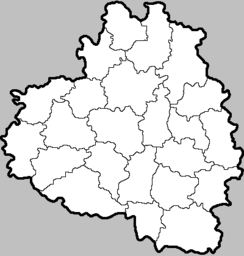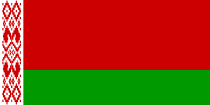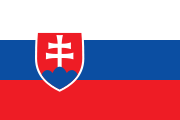Tula, Russia
| Tula (English) Тула (Russian) |
|
|---|---|
| — Inhabited locality — | |
Lenin Square in Tula |
|
.svg.png) Location of Tula Oblast in Russia |
|
 Tula
|
|
| Coordinates: | |
 |
 |
| Administrative status | |
| Country | Russia |
| Federal subject | Tula Oblast |
| Administrative center of | Tula Oblast |
| Municipal status | |
| Urban okrug | Tula Urban Okrug |
| Mayor | Alisa Tolkachyova[1] |
| Representative body | City Duma[2] |
| Statistics | |
| Area | 145 km2 (56 sq mi) |
| Population (2002 Census) | 481,216 inhabitants[3] |
| - Rank | 36th |
| - Density | 3,319 /km2 (8,600 /sq mi)[4] |
| Time zone | MSK/MSD (UTC+3/+4) |
| Founded | 1146[5] |
| Postal code(s) | 300000–300999[6] |
| Dialing code(s) | +7 4872[7] |
| Official website | |
Tula (Russian: Ту́ла) is an industrial city and the administrative center of Tula Oblast, Russia. It is located 193 kilometers (120 mi) south of Moscow, on the Upa River. Population: 481,216 (2002 Census).[3]
Contents |
History
The city has existed since at least the 14th century. Some historians believe that Tula should be identified with Taidula, an obscure locality mentioned in a chronicle under the year 1146.
In the Middle Ages, Tula was a minor fortress at the border of the Principality of Ryazan. As soon as it passed to Muscovy, a brick citadel, or kremlin, was constructed in 1530. It was a key fortress of the Great Abatis Belt and successfully resisted a siege by the Tatars in 1552. In 1607, Ivan Bolotnikov and his supporters seized the citadel and withstood a 4-months siege by the tsar's army. In the 18th century some parts of the kremlin walls were demolished. Despite its archaic appearance, the 5-domed Assumption Cathedral in the kremlin was built as late as 1764.
In 1712, Tula was visited by Peter the Great, who commissioned the Demidov blacksmiths to build the first armament factory in Russia. Several decades later, Tula was turned by the Demidovs into the greatest ironworking centre of Eastern Europe. The oldest museum in the city, showcasing the history of weapons, was inaugurated by the Demidovs in 1724, and Nicholas-Zaretsky Church in the city houses their family vault. The first factory to produce samovars industrially was also established there in the course of the 18th century. After the Demidovs moved the centre of their manufacture to the Urals, the city continued as a center of heavy industry, particularly in the manufacture of war matériel.
During the Great Patriotic War (World War II) of 1941 to 1945, the city was important in the production of armaments (Rifle wise: Tula produced more SVT-40 rifles than Mosin-Nagant M91/30, M38, and M44 rifles). Tula became the target of a German offensive to break Soviet resistance in the Moscow area between October 24 and December 5, 1941. The heavily fortified city held out, however, and Guderian's Second Panzer Army was stopped near Tula. The city secured the southern flank during the Soviet defence of Moscow and the subsequent counter-offensive. Tula was awarded the title Hero City in 1976. It is home to Klokovo air base.
Culture
A musical instrument, the Tula accordion, is named for the city, which is a center of manufacture for such instruments sold throughout Russia and the world. Tula is also renowned for traditional Russian pryaniki (gingerbread), cookies made with honey and spices (see Tula gingerbread). In the West, Tula is perhaps best-known as the center of samovar production: the Russian equivalent of "coals to Newcastle" is "You don't take a samovar to Tula".
The most popular tourist attraction in Tula Oblast is Yasnaya Polyana, the home and burial place of the writer Leo Tolstoy. It is situated fourteen kilometers south-west of the city. It was here that Tolstoy wrote his celebrated novels War and Peace and Anna Karenina.
Education
Tula is home to:
- Tula State University
- Tula State Pedagogical University[1]
- The Tula artillery and Engineering Institute
- A branch of the All Russia Economic and Finance Institute
- A branch of The Moscow Economics and Management Institute
Transport
Tula is a major railway junction with trains to Moscow, Orel, Kursk and Kaluga. The Moscow to Simpheropol M2 motorway runs past the city. City transport is presented by trams, trolleybuses, buses and marshrutkas.
Tram routes:
- 3.Moskovsky railway station-Sheglovskaya Zaseka
- 5.Pastry factory "Yasnaya Polyana"-Krasny Perekop
- 6.Shtykovaya street-"Metallurgist" Stadium
- 7.Sheglovskaya Zaseka-"Metallurgist" Stadium (only in rush hours)
- 8.Pastry factory "Yasnaya Polyana"-Shtykovaya street
- 9.Moskovsky railway station-"Metallurgist" Stadium
- 10.Pastry factory "Yasnaya Polyana"-"Metallurgist" Stadium
- 11.Sheglovskaya Zaseka-Krasny Perekop (only in rush hours)
- 12.Shtykovaya street-Krasny Perekop-Mendeleevsky Settlement
- 13."Metallurgist" Stadium-Krasny Perekop
- 14.Pastry factory "Yasnaya Polyana"-Mendeleevsky Settlement (through Phridrih Engels Street)
- 15.Shtykovaya street-Sheglovskaya Zaseka
Canceled routes:
- 1.Moskovsky railway station-Mendeleevsky Settlement (through Phridrih Engels Street, canceled in 2001)
- 2.Shtykovaya street-Mendeleevsky Settlement(through Phridrih Engels Street, canceled in 2003)
- 4.Mendeleevsky Settlement-Kosaya Gora Settlement (canceled in 2008)
- 16.Mendeleevsky Settlement-Combine Factory(through Phridrih Engels Street, canceled in 1987)
- 17.Moskovsky railway station-Pastry factory "Yasnaya Polyana"(canceled in 1980)
- K(old).Sovetskaya Street-Krasny Perekop-Stanislavskogo Street-Phridrich Engels Street-Sovetskaya Street (Circle route, canceled in 1972)
- K.Glinki Street-Demidovskaya Plotina Street-Sovetskaya Street-Krasny Perekop-Stanislavskogo Street-Phridrich Engels Street-Sovetskaya Street-Glinki Street (Circle route, canceled in 2004)
Trolleybus routes:
- 1.Malye Gonchary-South trolleybus station
- 2.Kurkovaya street (trolleybus depot)-South trolleybus station
- 3.Malye Gonchary-Moskovsky railway station
- 4.North trolleybus station-South trolleybus station (through Pervomayskaya street)
- 5.Moskovsky railway station-South trolleybus station (through Dmitry Ul'yanov street)
- 6.Moskovsky railway station-Gorelky Settlement
- 7.Kurkovaya street (trolleybus depot)-Moskovsky railway station
- 8.Moskovsky railway station-Tram depot (Krivoluch'e)
- 9.Airport (trade center "Penaty")-Tram depot (Krivoluch'e)
- 11.Moskovsky railway station-Victory Square (Bus Terminal)
Canceled routes:
- 4A.Airport-South trolleybus station (through Pervomayskaya street, canceled in 1995)
- 10.Tram depot (Krivoluch'e)-South trolleybus station (through Pervomayskaya street, canceled in 2010)
- K.Moskovsky railway station-Krasnoarmeysky Avenue-Sovetskaya street-Lenin Avenue-Pervomayskaya street-Dmitry Ul'yanov street-Moskovsky railway station (Circle route, canceled in 2001)
Bus routes:
- 1.Gorelky Settlement-Cementery №3
- 2.Moskovsky railway station-Likhvinka Settlement
- 9.Homyakovo Settlement-General Margelov street
- 10.Moskovsky railway station-Hospital (Maslovo Village)
- 11.RTI factory-Oktyabr'sky Settlement
- 12.RTI factory-Medvenka Village
- 13.Moskovsky railway station-Factory "Tulachermet"
- 14.Moskovsky railway station-Mikhalkovo Settlement
- 16.Moskovsky railway station-Regional dispensary
- 18.RTI factory-Child's regional hospital
- 20."Metallurgist" Stadium-Vysokoye village
- 21.Malye Gonchary- Sheglovskaya Zaseka
- 23.Gorelky Settlement-Regional dispensary (only in rush hours)
- 24.Malye Gonchary-Factory "Tulachermet"
- 25.Skuratovo Settlement (Set. Yuzhny, Set. Ugol'ny)-Regional dispensary
- 26.Beer factory "Baltika"-Skuratovo Settlement(Set. Zapadny)
- 27.Severny SeKttlement-Zapadny Settlement-Ugol'ny Settlement
- 28.Kosaya Gora Settlement-Factory "Tulachermet"
- 28T.Kosaya Gora Settlement-Factory "Tulachermet" (through Orlovskoye highway)
- 29.Kosaya Gora Settlement-Regional Hospital
- 29T.Kosaya Gora Settlement-Regional Hospital (through Orlovskoye highway)
- 36.Beer factory "Baltika"-Homyakovo Settlement
- 36A.Beer factory "Baltika"-Arkhangel'skoye Village
- 37.Moskovsky railway station-Trade center "Liniya"
- 38.Basovo-Prudny Settlement-Myasnovo (12th line)
- 44.Rozhdestvenno Settlement-Regional maternity hospital
Canceled routes:
- 3."Metallurgist" Stadium-Square of Revolt
- 4.Factory "Tulachermet"-Metallistov Street
- 5.Regional maternity hospital-Metallistov Street
- 6.RTI factory-Myasnovo (12th line)
- 7.Malye Gonchary-RTI factory
- 8.Malye Gonchary-Beer factory "Baltika"
- 10T.Cheluskintsev Square-"Metallurgist" Stadium
- 15.RTI factory-Beer factory "Baltika"
- 19.Child's regional hospital-Novomoskovskaya street
- 29(old).Sheglovskaya Zaseka-Recreation camp "Petushok"
- 30(before 1980).Moskovsky railway station-Victory Square (Bus Terminal)
- 30(after 1980).Metallistov Street-Child's regional hospital
- 31.Homyakovo Settlement-Square of Revolt
- 32.Victory Square (Bus Terminal)-Cementery №3
- 33.North trolleybus station-Krasnye Vorota (only in summer)
- 34.Oktyabr'sky Settlement-Square of Revolt
- 35.General Margelov street-RTI factory
- 39.Kosaya Gora Settlement-Skuratovo Settlement(Set. Zapadny)
Sport
In Russian fist fighting the region with the most famous fighters historically is Tula.[8][9]
The city Football club, FC Arsenal Tula plays in the Russian Amateur League
International relations
Twin towns — Sister cities
 Albany, United States
Albany, United States Mogilev, Belarus
Mogilev, Belarus Villingen-Schwenningen, Germany
Villingen-Schwenningen, Germany Banská Bystrica, Slovakia
Banská Bystrica, Slovakia
Gallery
|
Nikitskaya tower |
Spasskаyа Tower |
Tower of Odoyevsky gate |
Tower of Ivanovskys gate |
|
Uspenskiy Cathedral |
Church of Flor and Laurus |
Blagovestchenskaya Church |
Church of Prince Volodymyr |
|
Preobrazhenskaya Church |
Monument of Levsha |
Palace of Pioneers |
Tula samovar Museum |
References
- Notes
- ↑ Комсомольская правда: Михаил Иванцов будет сити-менеджером Тулы до 2014 года
- ↑ Official cite of Tula City Duma
- ↑ 3.0 3.1 Федеральная служба государственной статистики (Federal State Statistics Service) (2004-05-21). "Численность населения России, субъектов Российской Федерации в составе федеральных округов, районов, городских поселений, сельских населённых пунктов – районных центров и сельских населённых пунктов с населением 3 тысячи и более человек (Population of Russia, its federal districts, federal subjects, districts, urban localities, rural localities—administrative centers, and rural localities with population of over 3,000)" (in Russian). Всероссийская перепись населения 2002 года (All-Russia Population Census of 2002). Federal State Statistics Service. http://perepis2002.ru/ct/html/TOM_01_04_1.htm. Retrieved 2009-08-19.
- ↑ The value of density was calculated automatically by dividing the 2002 Census population by the area specified in the infobox. Please note that this value may not be accurate as the area specified in the infobox does not necessarily correspond to the area of the entity proper or is reported for the same year as the Census (2002).
- ↑ История Тулы на сайте Древо
- ↑ Почтовые индексы России
- ↑ Деловой город: Телефонный код Тулы
- ↑ "Тульские бойцы и ныне славятся, но каждое место имело своих удальцов." (Tula's fighters were always glorious, but every place had its heroes)
- ↑ "Лучшими бойцами один на один считались тульские" (The best fighters in one on one were considered Tula's fighters)
- ↑ "Црпй "Рскю" / Бяецн Рпх Онапюрхлю Рскш Нярюкняэ Б Лхпе". Tula.rfn.ru. 2005-04-29. http://tula.rfn.ru/rnews.html?id=2673&cid=9. Retrieved 2009-11-24.
External links
|
||||||||||||||
|
|||||